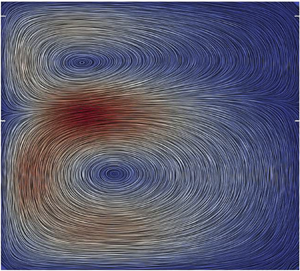Article contents
Nonlinear axisymmetric Taylor–Couette flow in a dilute gas: multiroll transition and the role of compressibility
Published online by Cambridge University Press: 08 December 2020
Abstract

The compressible Navier–Stokes–Fourier equations are numerically solved for axially bounded Taylor–Couette flow (TCF) of an ideal gas, with rotating inner cylinder and stationary outer cylinder, to understand the roles of compressibility and finite aspect ratio on the genesis of nonlinear Taylor vortices and the related bifurcation scenario. Restricting to the axisymmetric case in the wide-gap limit, the aspect ratio  $\varGamma =h/\delta$ (where
$\varGamma =h/\delta$ (where  $\delta$ is the annular gap between two cylinders and
$\delta$ is the annular gap between two cylinders and  $h$ is the height of the cylinders) is changed quasistatically by varying the height of the cylinders, following the experimental protocol of Benjamin (Proc. R. Soc. Lond. A, vol. 359, 1978b, pp. 27–43). The symmetric even-numbered (
$h$ is the height of the cylinders) is changed quasistatically by varying the height of the cylinders, following the experimental protocol of Benjamin (Proc. R. Soc. Lond. A, vol. 359, 1978b, pp. 27–43). The symmetric even-numbered ( $2,4,6,\ldots$) vortices are found at
$2,4,6,\ldots$) vortices are found at  $\varGamma \geq 2$, whereas the asymmetric 2-roll modes (called the single-roll or ‘anomalous’ modes), that break the midplane
$\varGamma \geq 2$, whereas the asymmetric 2-roll modes (called the single-roll or ‘anomalous’ modes), that break the midplane  $Z_{2}$-symmetry, are uncovered at
$Z_{2}$-symmetry, are uncovered at  $\varGamma \leq O(1)$. The phase boundaries of both symmetric and asymmetric rolls and the coexisting regions of different number of rolls are identified in the (
$\varGamma \leq O(1)$. The phase boundaries of both symmetric and asymmetric rolls and the coexisting regions of different number of rolls are identified in the ( $\varGamma , Re$)-plane. These phase diagrams, along with related bifurcation diagrams and various patterns, at finite Mach numbers (
$\varGamma , Re$)-plane. These phase diagrams, along with related bifurcation diagrams and various patterns, at finite Mach numbers ( $Ma$) are contrasted with their incompressible (
$Ma$) are contrasted with their incompressible ( $Ma\to 0$) analogues. It is shown that the ‘
$Ma\to 0$) analogues. It is shown that the ‘ $1\leftrightarrow 2$’-roll transition in small aspect ratio cylinders is subcritical in compressible TCF in contrast to the supercritical nature of bifurcation in its incompressible counterpart. In general, the gas compressibility has a stabilizing effect on nonlinear Taylor vortices as the underlying phase diagrams in the (
$1\leftrightarrow 2$’-roll transition in small aspect ratio cylinders is subcritical in compressible TCF in contrast to the supercritical nature of bifurcation in its incompressible counterpart. In general, the gas compressibility has a stabilizing effect on nonlinear Taylor vortices as the underlying phase diagrams in the ( $\varGamma , Re$)-plane are shifted to larger values of
$\varGamma , Re$)-plane are shifted to larger values of  $Re$ with increasing
$Re$ with increasing  $Ma$. The stabilizing role of compressibility can be tied to the weakening of the outward jets, which is further aided by the strengthening of the Ekman vortices with increasing Mach number.
$Ma$. The stabilizing role of compressibility can be tied to the weakening of the outward jets, which is further aided by the strengthening of the Ekman vortices with increasing Mach number.
Information
- Type
- JFM Papers
- Information
- Copyright
- © The Author(s), 2020. Published by Cambridge University Press
References
REFERENCES
- 5
- Cited by

